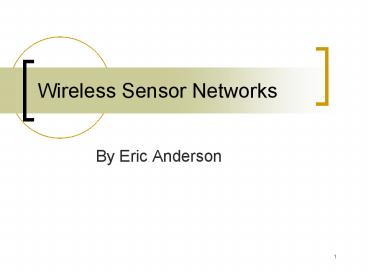Wireless Sensor Networks PowerPoint PPT Presentation
1 / 19
Title: Wireless Sensor Networks
1
Wireless Sensor Networks
- By Eric Anderson
2
Introduction
- Wireless Sensor Network (WSN) An autonomous, ad
hoc system consisting of a collective of
networked sensor nodes designed to
intercommunicate via wireless radio.
3
Introduction
- Wireless Communication via radio waves
- Autonomous Independent self-directed
- Ad hoc network A network without a fixed,
well-defined infrastructure - Sensor node Device that produces a measurable
response to a change in physical condition
4
Node Classification
- Individually addressable
- Each node is uniquely identified, facilitates
object-based organization - Ex Parking lot spaces
- Network data is aggregated
- Messages broadcast, reduction in network
bandwidth - Ex Temperature in room corner
5
Node Examples
6
WSN Goals
- Tracking Detect and track objects
- Classification Classify objects
- Estimation Estimate parameters and events of
interest pertaining to objects - Determination Determine the value of some
parameter at a given location
7
WSN Requirements
- Stationary or Mobile use
- Low energy consumption
- Self-organization and autonomy (locality)
- Robust and scalable
- Collaborative signal processing (emergent
behavior through data fusion) - Querying ability (possible message routing via
cluster head promotion)
8
Types of WSNs
- Environmental
- Medical
- Military
- Urban
- Civic
- Industrial
- Residential
9
Environmental Usages
- Search and rescue
- Disaster relief
- Climate monitoring (weather prediction)
- Seismic detection (earthquakes, volcanos)
- Pollution tracking (patterns, density)
- Habitat monitoring (endangered species,
www.greatduckisland.net) - Geophysical monitoring (forest fires, river
currents, contaminants, global warming, farms,
marine microorganisms)
10
Environmental Requirements
- Energy efficiency (long battery life)
- Intermittent connectivity
- Schedule sleep mode for redundant sensors
- Inexpensive nodes (large quantity needed)
- Reduced size of nodes (small, microscopic)
- Auto-configuration of sensors
- Scalable network
- Robust nodes to handle harsh environments (heat,
water, snow, humidity, wind)
11
Medical Usages
- Health care (insurance cards)
- Patient monitors (pulse, heart rate, glucose
levels, child tracking, eye implants,
defibrillators) - Cybernetic enhancements
- Information tags (allergies, severe reactions)
- Medication notification system
12
Medical Requirements
- Energy efficiency (long battery life,
heat/kinetic/bio battery) - Hidden device (not visually detectable)
- Biologically safe
- Fault-tolerant, reliable
- Encrypted bio information
- Interference-safe (RF noise, 900 MHz)
13
Military Usages
- Tactical surveillance (land, sea)
- Tracking troop movement (both sides)
- Ubiquitous, undetected smart mines
- Battlefield communication
- Detection of hazardous agents (explosive,
nuclear, biological, poisonous, radioactive) - Environmental awareness (terrain mapping)
14
Military Requirements
- Energy efficiency (long battery life)
- Schedule sleep mode for redundant sensors
- Ubiquitous and Undetectable
- Auto-deployment and self-organization
- Fault-tolerant, reliable
- Strong Encryption (low overhead)
- Auto-configuration of sensors
- Scalable network
- Robust nodes to handle harsh environments (heat,
water, snow, humidity, wind)
15
Urban Usages
- Civic
- Transportation systems (traffic)
- Auto-identification (drivers license)
- Parking lot availability sensors
- Security monitors (shopping malls, parking
garages, city streets) - Child abduction prevention
- Automated parking meter update
16
Urban Usages
- Industrial
- Hotel room smart service
- Ubiquitous gambling cameras
- Product distribution (UPS)
- Inventory tracking/control
- Worker efficiency and daily routine (company
badges) - Quality assurance, process control
17
Urban Usages
- Residential
- Home security
- Digital canvas
- Smart appliances (lights, thermostat, television,
stereo, etc.) - Life alert system (elderly, children near pool)
- Pet tracking (angel alert proximity detector)
- Dirt sensors (alert home owner when specific
quadrants exceed dust/dirt quota)
18
Urban Requirements
- Inexpensive nodes (large quantity needed)
- Reduced size of nodes (small, medium)
- Robust nodes to handle harsh environments
(climate, people) - Diverse range of sensor types (audible, visual,
location, etc.) - Interoperability (interface with home, commercial
and government systems) - Highly customizable (diverse user base)
- Scalable network (wide area of coverage)
19
References
- http//www.cs.uno.edu/golden/MobileBook/
- M. Kochhal, L. Schwiebert, Sandeep Gupta.
Role-based Hierarchical Self Organization for
Wireless Ad hoc Sensor Networks - J. Elson, K. Romer. Wireless Sensor Networks A
New Regime for Time Synchronization. ACM SIGCOMM
Computer Communications Review, volume 33,
January 2003. - Smart Sensor Networks. Advanced Network
Technologies Division, Nation Institute of
Standards and Technology. May 2001. - D. Estrin, R. Govindan, J. Heidemann. Embedding
the Internet. Communications of the ACM, volume
43, May 2000. - A. Mainwaring, J. Polastre, R. Szewczyk, D.
Culler, J. Anderson. Wireless Sensor Networks for
Habitat Monitoring. WSNA 02, September 2002. - K. Romer, O. Kasten, F. Mattern. Middleware
Challenges for Wireless Sensor Networks. Mobile
Computing and Communications Review, volume 6,
July 2002.

